PORTLAND, Ore., – Helping stranded drivers on the side of the road should not be one of America’s most deadly jobs, but it is. On average, two emergency responders, including tow workers, are struck and killed every month in the U.S. by drivers who fail to obey the law by moving over to an adjacent lane and allowing the roadside rescuers the space to operate safely, according to the Bureau of Labor Statistics.
Roadside crashes are notably deadly for tow workers. Government data shows that tow operators are killed at a rate of almost 43 deaths per 100,000 workers, compared to just three for all other industries.
In Oregon, 10 people were killed in crashes while outside a disabled vehicle from 2016 through 2020. Nationwide, 1,703 were killed in that same timeframe, according to the National Highway Traffic Safety Administration’s Fatality Analysis Reporting System (FARS).
While all 50 States have Slow Down Move Over laws, driver awareness and compliance are inconsistent. With highway speeds often 65 mph or more, drivers may find it difficult to spot and react to incident response personnel, including tow truck drivers, police, and emergency responders.
The AAA Foundation for Traffic Safety did two different studies to see what could be done to better protect roadside workers.
The AAA Foundation also surveyed tow workers, emergency responders, and road maintenance workers on their experiences with roadside jobs. Of those surveyed, 60% had experienced a near miss while working at the roadside, while an astonishing 15% had survived being hit by a passing vehicle.
Here’s video of AAA Oregon technician Dan Gamble who was assisting a AAA member on I-5 southbound in Portland, south of the Terwilliger curves, with traffic whizzing by just inches away. Find photos below.
https://www.youtube.com/watch?v=6Zo3RwByqXw
Find more b-roll video and photos below.
The studies – what worked to get drivers to slow down and move over?
The AAA Foundation for Traffic Safety looked at devices and warning messages, including cones, flares, emergency flashing light patterns, and electronic variable message signs (VMS) to see which were most effective. The studies show that the odds of a driver moving a vehicle over a lane were 95% higher when VMS were used. Cones, flares, and emergency flashing light patterns led to significant lane shifts by drivers but were less effective at reducing speeds.
One study (here is the fact sheet) assessed the behavior of motorists passing a roadside incident with varying combinations of flares, cones, and two different light patterns: a Daytime light pattern representative of the emergency lighting currently in widespread use and a Nighttime light pattern designed to avoid masking road safety personnel working at the roadside at night. The staged incident consisted of a flatbed tow truck with the Daytime or Nighttime light pattern activated, 6 feet in front of a silver sedan with hazard flashers operating, on the shoulder of a multilane, limited access highway. Video data was processed using computer vision techniques to estimate lane occupancies and speed.
- During the day, lights on a tow truck resulted in a 25% increase in vehicles shifting lanes compared to when the truck and client vehicles were not present.
- At night, light patterns resulted in a 41% increase in lane shifts.
- Neither flares nor cones produced a significant change in lane occupancy during the day.
- When flares were added to the truck displaying lights at night, the occupancy of Lane 1 decreased significantly beyond the level achieved by the truck and lights alone. The addition of cones, however, produced only a very small additional reduction that did not reach statistical significance.
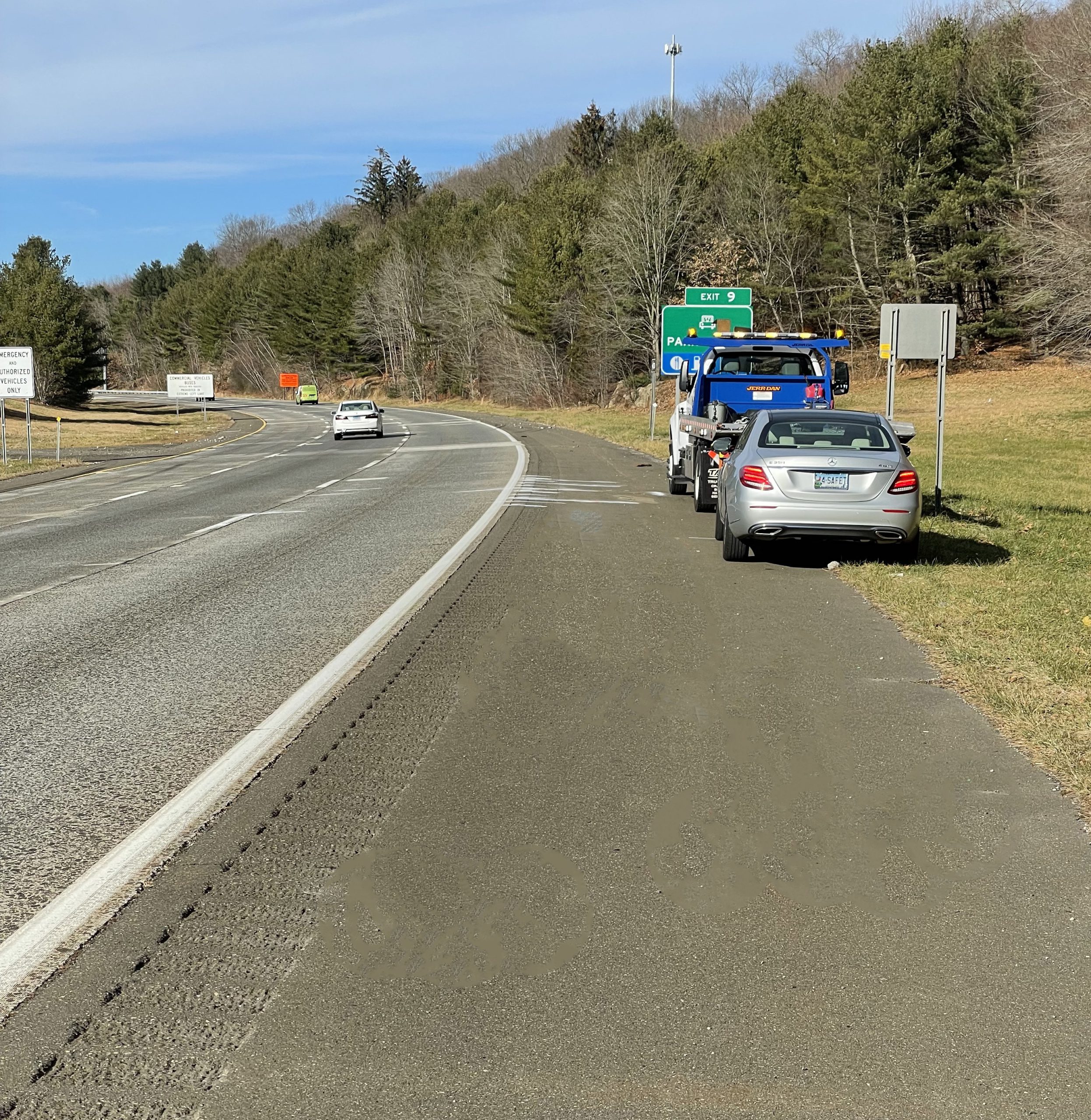
The staged incident consisted of a flatbed tow truck 6 feet in front of a silver sedan.
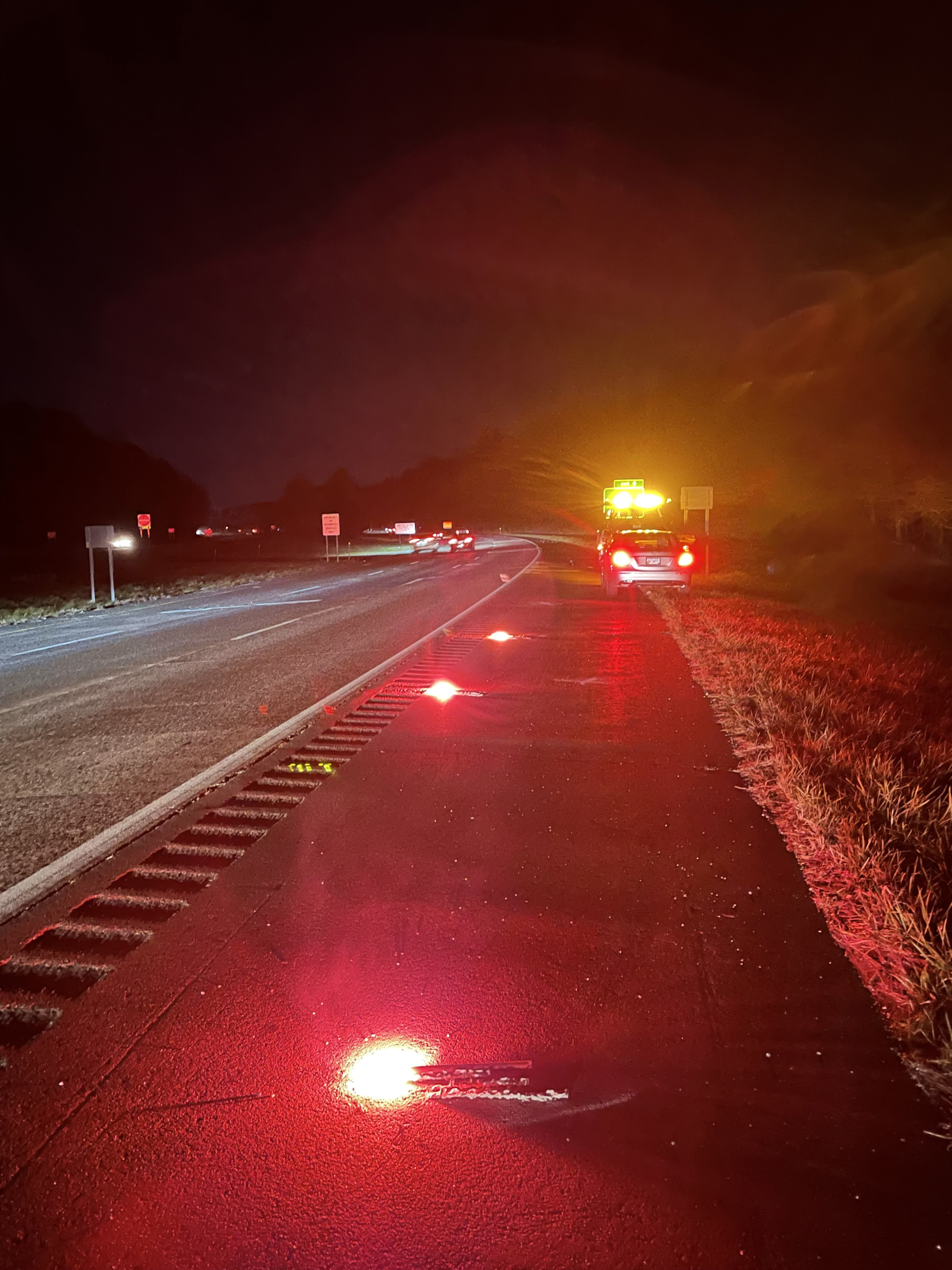
Nighttime set-up with flares and flashing lights
A second study (here is the fact sheet) evaluated the effectiveness of a vehicle-mounted variable message sign (VMS) in promoting safer behaviors in passing motorists. Additionally, the study gathered information about workers’ perceptions and adoption or use of different countermeasures.
- When the VMS was active, drivers were more likely to move over (change lanes) and slow down than in the cases when the VMS was not active. The odds of a vehicle moving over were 95% higher when the VMS is used.
- Passenger vehicles were more responsive to VMS use than trucks or buses (although both vehicle types are more likely to move over when VMS is active compared to when not).
- If a vehicle was making a lane change, its speed also tended to be lower than those who stayed in a lane.
- The presence of service personnel working outside of the vehicle on the roadside tended to increase the likelihood of passing vehicles moving over.
Here are videos of a VMS sign:
VMS sign – diamond pattern
https://info.oregon.aaa.com/wp-content/uploads/2023/02/VMS-Sign-Broll.mov
Tight shot of a VMS sign – diamond pattern
https://info.oregon.aaa.com/wp-content/uploads/2023/02/Tight-Shot-of-a-VMS-Sign-Diamond-pattern.mov
Insights from Survey and Focus Groups:
- Survey respondents from the towing and recovery industry had the highest odds of experiencing a (self-reported) struck-by incident compared to any other agency group, except for fire departments, which were equivalent.
- Responders with Traffic Incident Management (TIM) training did not experience lower odds of being involved in struck-by or near miss incidents than responders without training.
- High-visibility apparel and emergency vehicle lighting were the two most frequently used countermeasures by the respondents. Complacency was the most common reason cited for not always using high-visibility clothing.
Next Steps
The results from the AAA Foundation field studies suggest that using VMS, nighttime light patterns, cones, or flares can positively impact the behaviors of passing motorists under most circumstances. AAA strongly recommends service vehicles or fleets utilize these features, to protect these roadside heroes.
“AAA is using this research to bring awareness to Slow Down Move Over laws and to promote the adoption of lifesaving equipment to protect tow workers and first responders. AAA is sharing these findings with the impacted industries and traffic safety advocates,” says Marie Dodds, public affairs director for AAA Oregon/Idaho.
Slow Down Move Over Laws have limited success
AAA and other traffic safety advocates have helped get Slow Down Move Over laws passed in all 50 states and the District of Columbia.
In Oregon, drivers must move over to another lane or slow down at least five miles per hour below the posted speed limit when approaching first responders (police fire, and ambulance), tow trucks, municipal and road maintenance vehicles, utility vehicles, as well as any vehicle that is stopped and is displaying warning or hazard lights, or a person is indicating distress by using emergency flares or posting emergency signs. The fine for a violation is $265 or $525 if within a safety corridor, school zone or work zone. (ORS 811.147) https://www.oregon.gov/odot/safety/pages/enforcement.aspx
Unfortunately, a previous AAA study shows that many drivers don’t comply with Slow Down Move Over laws, and others aren’t even aware that these laws exist.
“We examined this safety challenge because these crashes are avoidable if drivers slow down and move over to allow roadside workers the space to carry out their duties safely,” said Dr. David Yang, president and executive director of the AAA Foundation for Traffic Safety. “We must help motorists see and react appropriately whenever an emergency responder is on the side of the road.”
AAA has tips for drivers to protect emergency responders, roadside workers and drivers with disabled vehicles:
- Remain alert, avoid distractions and focus on the task of driving.
- Keep an eye out for situations where emergency vehicles, tow trucks, utility service vehicles or disabled vehicles are stopped on the side of the road.
- When you see these situations, slow down and if possible, move one lane over and away from the people and vehicles stopped at the side of the road.
- If you are driving, don’t get impaired. If you’re impaired, don’t drive.
“Please slow down and move over if you see a vehicle, person, or warning lights, flares or cones on the shoulder ahead. You could be saving someone’s life,” says Dodds. “AAA service techs and other emergency responders are often only just a few inches away from speeding vehicles as they do their jobs. Let’s keep them safe!”
Additional B-roll video and photos
Slow Down Move Over animation
https://info.oregon.aaa.com/wp-content/uploads/2023/02/SDMO-Animation.mp4
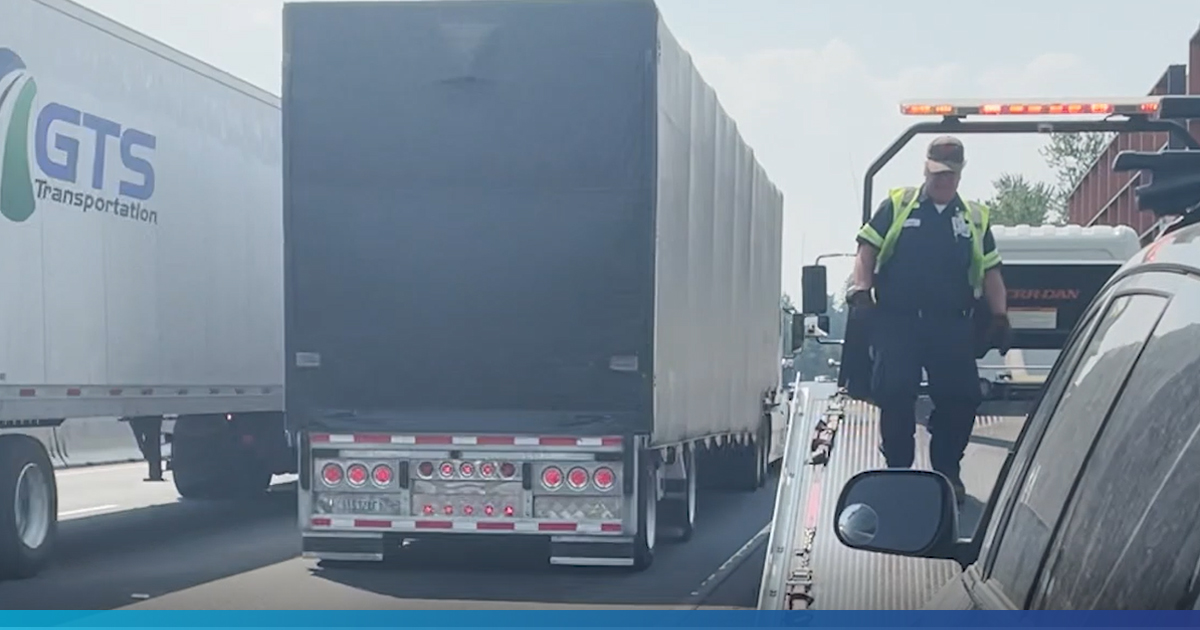
AAA service techs often do their work within inches of traffic speeding by. These photos were taken on I-5 southbound near Barbur Blvd. in Portland.

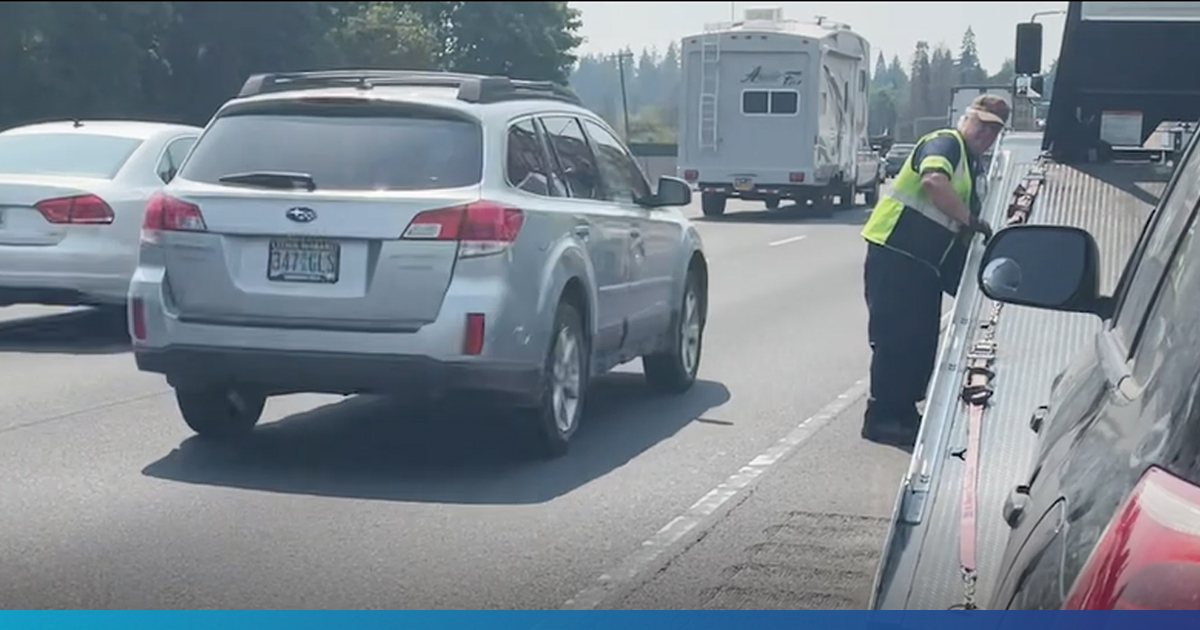
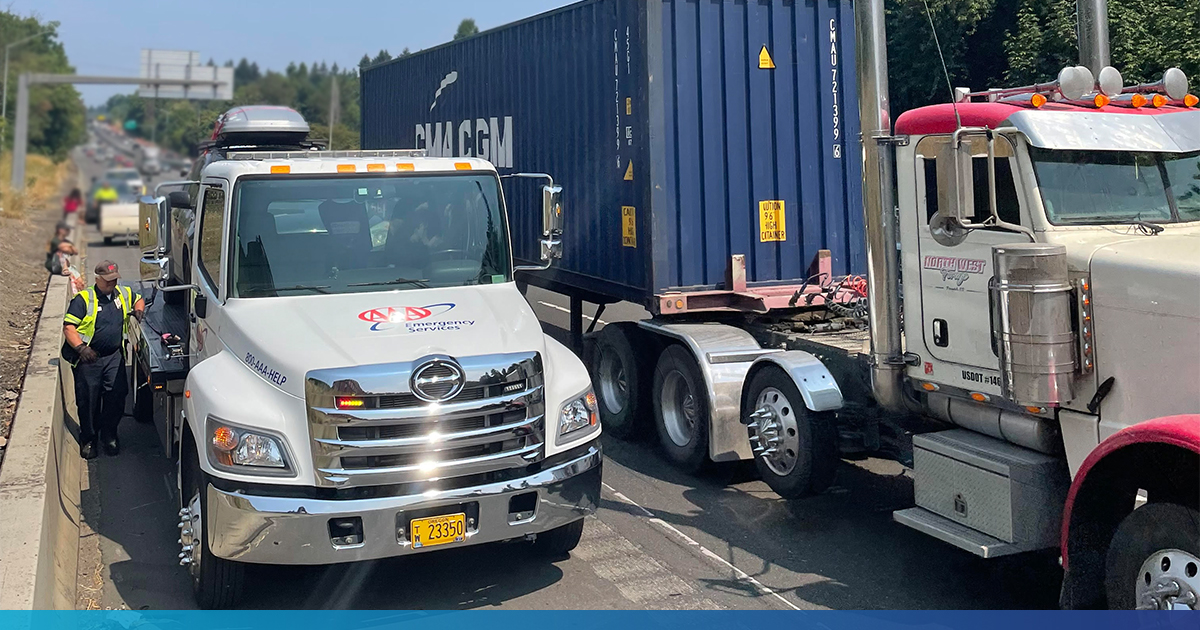
About the AAA Foundation for Traffic Safety
Established in 1947 by AAA, the Foundation for Traffic Safety is a nonprofit, publicly funded 501(c)(3) charitable research and educational organization. The AAA Foundation’s mission is to prevent traffic deaths and injuries by researching their causes and by educating the public about strategies to prevent crashes and reduce injuries when they do occur. This research informs the development of educational materials for drivers, pedestrians, bicyclists, and other road users.
AAA news releases, high resolution images, broadcast-quality video, fact sheets and podcasts are available on the AAA NewsRoom at NewsRoom.AAA.com.
Find local news releases at https://oregon.aaa.com/community/media/media-contacts.html

